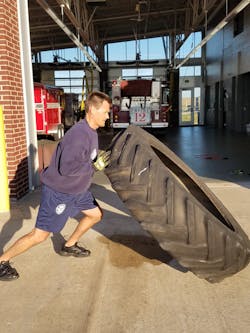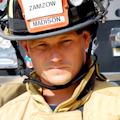As firefighters we use tools to help us do our job on the fire and rescue scene. We have tools for forcible entry, extrication, EMS, as well as special hose and nozzles for fire attack, protective gear to help us endure our dangerous environment, ladders of varying lengths and very expensive apparatus. We also have tools that can help us stay in shape and fit for duty.
But what are the firefighter fitness tools of the trade? The “traditional” fitness tools—dumbbells, squat racks, bars and plate weights—are probably what comes to mind first. Growing in popularity around most fire department weight rooms are the “functional” fitness tools, such as TRX, stability balls, medicine balls and resistance bands. Then there are the fireground-related fitness tools that, if properly used, can help simulate fireground movement patterns and help to mimic “game-time” fitness requirements and situations. These items include tractor tires, foam buckets, fire hose, the BlastMask, weighted vests (like the PWR sandbag trainer), Steelhoses and sledgehammers.
All of these tools are very good at developing the needed fitness components of the fireground. Unfortunately, there is a cost associated with them, and they are often the first items to get cut due to budgetary restraints. This, of course, is a short-sided approach to fitness and one that we as fitness advocates hope to help change.
We’ll review some of these firefighter fitness tools here, and then delve into a group of tools that I consider to be essential for the challenging physical components of the job.
Traditional fitness tools
Traditional fitness tools include dumbbells, weights, squat racks and cable columns. Weights and dumbbells have been used for many years and are the “go-to” when it comes to developing strength, power and endurance. Dumbbells are versatile and can be used for an endless number of exercises. And unlike traditional machines, you can have multiple people working out with them at the same time. Cable columns provide a different resistance to that of dumbbells or weights, have a very small footprint, and can be easily adjusted to fit a wide variety of strength levels and sizes. The squat rack is another versatile tool, as it will allow you to strengthen your lift and, more importantly, teach you to lift safely. There are an endless number of exercises that can be performed with the rack, especially when paired with an Olympic bar and plate weights.
Functional fitness tools
Functional tools include TRX, stability balls, foam rollers and kettlebells. Functional fitness equipment is versatile and can adapt to where, how and what you are training. The beautiful part about functional fitness equipment is that it allows you to train your muscles to work together by simulating everyday movements and movements you would use on the fireground. Suspension trainers, like the TRX, are great tools that use your own bodyweight to build total body strength, challenge your core and add a ton of variety to your training. These pieces of equipment are portable and don't require a lot of space. Stability balls (also called an exercise ball, Swiss ball or physioball) are a simple yet versatile piece of training equipment that helps improve core strength, balance and coordination. Stability balls come in a variety of sizes and can be used in small areas. Foam rollers are very popular and available at most department and sports stores for a minimal investment. I recommend having a foam roller at the station and to use it as much as you can. Personally, I have one at home and one at the station and use them after demanding calls, workouts or just long shifts. Kettlebells can be used in a large array of exercises as a substitution (or as an addition) to dumbbells. They also promote a strong grip and prepare the wrist to accommodate ballistic shock and demand experienced during fire and rescue ground activities.
Fireground fitness tools
Fireground fitness tools—the BlastMask, PWR sandbags, tractor tires, foam buckets and fire hose—help improve performance by simulating more “game-time” movement patterns. These are tools that improve SCBA breathing, tactical preparedness, confidence and performance. The BlastMask is a great tool that can improve your VO2 max and increase your efficiency while using a SCBA. It attaches to your mask and simulates the real-world SCBA breathing. PWR sandbags are a durable alternative to wearing a SCBA during workouts. The sandbags system can be worn on your back to simulate the weight and feel of the SCBA or used for pulls, drags and slams. Tractor tires are another fitness tool that can be used to help improve fireground performance. Tires can be flipped to improve squat techniques or used as a medium for sledges and drags. Foam buckets are also a great option to add resistance to climbing stairs or hoisting. The liquid moving within the bucket as you move improves the stabilizing muscles and forces your body to work harder. Finally, fire hose can be used for drags, battling hoselines or as a prop for carrying. Using fire hose helps to improve fireground dexterity and grip strength as well.
Essential tools
While the traditional, functional and fireground tools are great, the following “essential” tools are those that you should obtain and get familiar with before you even consider picking up a weight or flipping a tractor tire. The good news about these fitness tools is that a majority of them do not require a large investment, if any, to obtain.
Fitness program
The first item in your firefighter fitness toolbox should be a solid workout program. The purpose of any firefighter workout program should be to improve performance on and off the fire/rescue ground and to help reduce injuries. In order to do this, you must follow a plan. On the fireground, a command staff evaluates the situation and creates an action plan to mitigate the situation. You should approach your fitness the same way. A solid program should improve your flexibility, add strength and power, and improve your cardiovascular capacity. As such, make sure your program includes core training, active warm-up and stretching, foam-rolling, full-body strength exercises, and intervals. Make sure that any program you follow has legitimacy and is written by individuals who are certified and experienced in fitness programming and understand the functional demands of the fire rescue athlete. You wouldn’t get information about fire attack from a rookie or from someone outside of the fire service; the same needs to apply with your fitness.
Water bottle
We all know that water is important to help us put out fires, but did you know that water also helps with performance and can actually reduce chances of sudden cardiac arrest and stroke? Dehydration causes a drop in blood volume and it causes blood, which is primarily water, to thicken. This causes your heart to pump harder in an effort to maintain appropriate cardiac output and blood pressure, especially when trying to meet the demands of the fireground.
Hydration is also critical for optimal performance. Progressive dehydration from exercise (or fireground operations) impairs performance, mental capacity, perception of effort, and can be life-threatening. With as little as a 2 percent body water shortage, the ability to perform a high-intensity activity can be greatly impaired. Translate that statistic onto the fireground, and that could mean death or injury to you or a crewmember because your performance is greatly reduced. All this is reason to have a good, filled water bottle always on hand. To combat dehydration, firefighters should intake at least 64 ounces (8 cups) a day at a minimum. This amount should increase depending on weather, call volume and size.
Healthy nutrition plan
You cannot out-train poor nutrition. Good fitness results cannot be achieved without a healthy diet and sound nutrition. Nutrition is the basis for all energy in the body. If you put poor food in your body, it will penalize you with poor performance and health issues. Keep this in mind the next time you put that donut or sugary soda in your mouth. Proper nutrition can also combat major diseases, improve stress and boost your immune system. In order to improve performance, you have to plan your nutrition wisely. For basics, try to minimize sugars, eat healthy fats, lots of fruits and vegetables and try to stick to natural, one-ingredient foods. Try not to get too complicated, find some healthy eating habits that work for you and stick with them. Nutrition is not a good “fitness tool” unless it is followed consistently.
Annual physical/periodic assessments
Yearly assessments are an essential tool for all firefighters especially in our industry where physical work is deemed an essential job function. The purpose of any fitness-related testing is to assess your current level of health and monitor changes (positive or negative) from year to year. NFPA 1583 states that firefighters should undergo a fitness assessment at least annually and should be composed of five elements: aerobic capacity, body composition, muscular strength, muscular endurance, and flexibility. I would also recommend adding some type of functional movement screen to the list. These tests are great tools to assess potential injury risks and provide useful individual feedback that can address areas of functional weakness. If your department has a trained health and fitness coordinator or trainer, these tests can be easily administered with some basic equipment. Otherwise, the department should contact a local agency or health club to provide the testing and certified personnel.
In sum
There are plenty of options when it comes to fitness tools for firefighters. I’m sure you are familiar with the more traditional and common tools and hopefully were pleasantly surprised by the others on the list. In order for fitness to improve, there has to be a plan, proper hydration, good nutrition and a process in place that monitors progress (or decline). Without these essential “tools,” the traditional-, functional- and fireground-related fitness tools can be ineffective and potentially harmful. Evaluate your current level of fitness. Are you using these tools? If not, start today. Your career, your crew and your body will thank you.
About the Author
Aaron Zamzow
Aaron Zamzow is a firefighter/training officer for Madison, WI, Fire Department. He holds a bachelor’s degree in health/wellness and has 20 years of experience as a fitness trainer. He created Fire Rescue Fitness and authors programs that are aimed at getting fire rescue athletes fit for duty.

